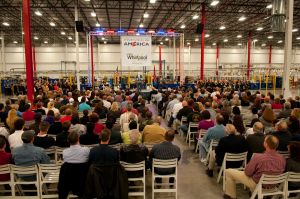Manufacturing Companies Realize Competitive Advantages Through Employee Awareness and Engagement
For the average manufacturing worker, the threat of losing a job or taking days off without pay is a lingering possibility. Most are just grateful to be employed, and their employers are working hard to keep it that way by creating a culture that encourages them to stay and feel valuable.

 |
| Lyle Hanna, president and CEO of Hanna Resource Group |
Hiring freezes, layoffs, and plant shutdowns can be unfortunate results of a recession.
For the average manufacturing worker, the threat of losing a job or taking days off without pay is a lingering possibility. Most are just grateful to be employed, and their employers are working hard to keep it that way. Lyle Hanna is president and CEO of Hanna Resource Group and counsels employers on human resource issues. Even though the U.S. labor pool is vast due to high unemployment (12.7 million remained unemployed according to the latest estimate by the Bureau of Labor Statistics), he says it is more important than ever to keep your existing workforce happy.
“You can’t afford to lose anybody that you have because it’s hard to recruit people right now,” said Hanna. “There are still a lot of people who are unemployed, but finding good workers is just harder than ever.”
 |
| Amy Killam, human resources director of Whirlpool Corporation’s Cleveland, Tenn. operations |
A sentiment shared by Amy Killam, human resources director of Whirlpool Corporation’s Cleveland, Tenn. operations. Killam says because the Cleveland area is bustling with new manufacturers and other businesses, the area possesses a strong labor pool but the competition for good workers is intense.
“There are a lot of new employers coming in…Volkswagen, Wacker and Amazon have built new facilities,” said Killam. “So that forces us to make sure we are being very competitive with our benefits and compensation package.”
While benefits and compensation are vital to retaining employees, Killam says there are other less obvious ways employees at her plant are incented to stay.
“Everybody wants to be paid well, and that’s certainly an important piece of it,” began Killam. “But, at the end of the day when wages level off and everyone’s paying more or less the same, you have to think about what’s really going to draw that person to want to work at your company. Do they want to work in a place where they’re told what to do from A-to-Z, or do they want to come in and have some autonomy? Do they want to like the team they work with? Do they want to feel like part of a team versus not really knowing anyone, or talking to anyone? That’s a tough way to work day-in and day-out. And so for us, it really is important to focus on the culture we create for our employees.”
 |
| Employees at Whirlpool’s new Cleveland, Tenn. facility gathered to celebratethe plant’s dedication in March 2012. |
Killam says Whirlpool places great emphasis on creating a company culture where people will not only want to come to work, but will thrive on their own accomplishments.
“When I talk about culture, I’m talking about how do you create great leaders?” Killam began. “How do you make sure every team member, regardless of their job, is a problem solver that gets some autonomy in their job? Our hope is to build an environment that really draws people, and they want to come be a part of this team.”
Hanna helps manufacturers and other employers develop rich and inviting cultures where employees feel valuable. In fact, his company utilizes a tool developed by the Metrus Group called ACE—which stands for alignment, capability and engagement—and assesses the warmth of a company’s work environment.
“In alignment, it’s important to make sure that people understand their part in the organization,” began Hanna. “What part do they play in the success of the organization? How does what they do impact the ultimate bottom line or the success of the organization? And when people have that alignment, they feel a lot better about being there.”
“The second thing is capability,” he continued. “That is making sure that you get the right people, in the right jobs, with the right tools and talent. People hate to be in jobs where they can’t do their best because they don’t have the necessary tools or haven’t been trained to do it properly.”
“And E stands for engagement. You have people engaged, and that means they get excited about what they’re doing. They like this place enough that they tell other people—their friends, relatives and neighbors—they ought to work here. And, that all depends on how they are treated in the work environment.”
Hanna said he is aware of a company that recently lost six of its executives. He believes that a poor work environment combined with a recovering economy is the reason. “If you haven’t treated people well, if you haven’t taken care of your ACE, then when things improve there’s a far better chance people are going to jump ship and try something else because they lose their loyalty to you over that time,” he said.